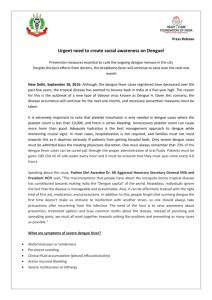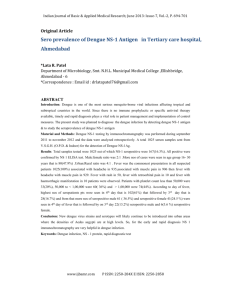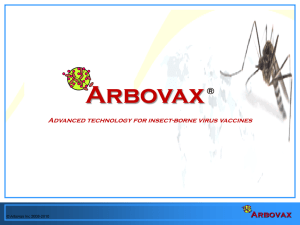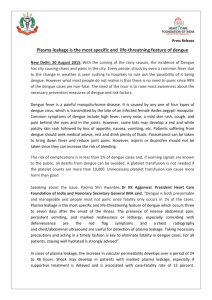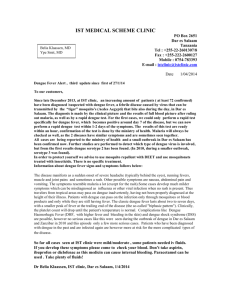Dengue 4 is less fatal: IMA It`s not an epidemic yet: IMA New Delhi
advertisement
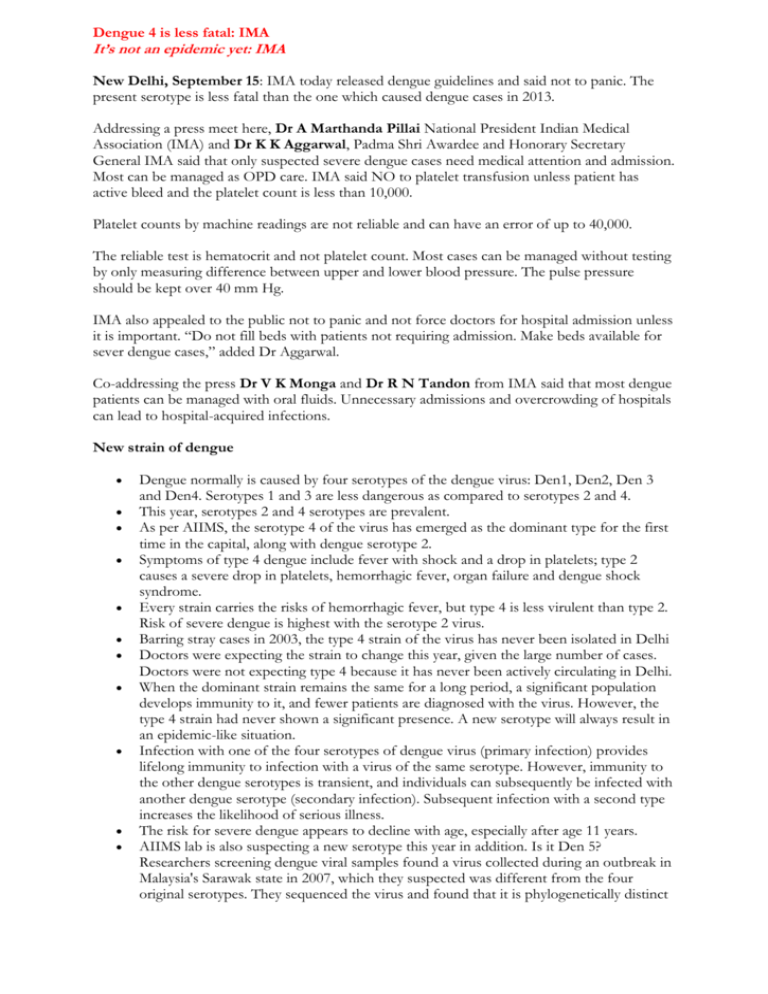
Dengue 4 is less fatal: IMA It’s not an epidemic yet: IMA New Delhi, September 15: IMA today released dengue guidelines and said not to panic. The present serotype is less fatal than the one which caused dengue cases in 2013. Addressing a press meet here, Dr A Marthanda Pillai National President Indian Medical Association (IMA) and Dr K K Aggarwal, Padma Shri Awardee and Honorary Secretary General IMA said that only suspected severe dengue cases need medical attention and admission. Most can be managed as OPD care. IMA said NO to platelet transfusion unless patient has active bleed and the platelet count is less than 10,000. Platelet counts by machine readings are not reliable and can have an error of up to 40,000. The reliable test is hematocrit and not platelet count. Most cases can be managed without testing by only measuring difference between upper and lower blood pressure. The pulse pressure should be kept over 40 mm Hg. IMA also appealed to the public not to panic and not force doctors for hospital admission unless it is important. “Do not fill beds with patients not requiring admission. Make beds available for sever dengue cases,” added Dr Aggarwal. Co-addressing the press Dr V K Monga and Dr R N Tandon from IMA said that most dengue patients can be managed with oral fluids. Unnecessary admissions and overcrowding of hospitals can lead to hospital-acquired infections. New strain of dengue Dengue normally is caused by four serotypes of the dengue virus: Den1, Den2, Den 3 and Den4. Serotypes 1 and 3 are less dangerous as compared to serotypes 2 and 4. This year, serotypes 2 and 4 serotypes are prevalent. As per AIIMS, the serotype 4 of the virus has emerged as the dominant type for the first time in the capital, along with dengue serotype 2. Symptoms of type 4 dengue include fever with shock and a drop in platelets; type 2 causes a severe drop in platelets, hemorrhagic fever, organ failure and dengue shock syndrome. Every strain carries the risks of hemorrhagic fever, but type 4 is less virulent than type 2. Risk of severe dengue is highest with the serotype 2 virus. Barring stray cases in 2003, the type 4 strain of the virus has never been isolated in Delhi Doctors were expecting the strain to change this year, given the large number of cases. Doctors were not expecting type 4 because it has never been actively circulating in Delhi. When the dominant strain remains the same for a long period, a significant population develops immunity to it, and fewer patients are diagnosed with the virus. However, the type 4 strain had never shown a significant presence. A new serotype will always result in an epidemic-like situation. Infection with one of the four serotypes of dengue virus (primary infection) provides lifelong immunity to infection with a virus of the same serotype. However, immunity to the other dengue serotypes is transient, and individuals can subsequently be infected with another dengue serotype (secondary infection). Subsequent infection with a second type increases the likelihood of serious illness. The risk for severe dengue appears to decline with age, especially after age 11 years. AIIMS lab is also suspecting a new serotype this year in addition. Is it Den 5? Researchers screening dengue viral samples found a virus collected during an outbreak in Malaysia's Sarawak state in 2007, which they suspected was different from the four original serotypes. They sequenced the virus and found that it is phylogenetically distinct from the other four types. Experiments found that monkey antibodies produced against the new type differ significantly from those resulting from the previously known dengue viruses. So far, dengue 5 has been linked to only one outbreak in humans. In 1996, when an outbreak of the disease was reported in Delhi with over 10,000 cases, the relatively severe type 2 strain of the virus was identified as the most common serotype. In 2003, when a sharp rise in dengue cases was again reported, type 3, a mild strain, emerged as the most common serotype. In 2013, with over 5,500 cases, serotype 2 returned as the common strain in the capital. Most dengue patients are not serious Dengue is both preventable and manageable. The risk of complications is in less than one percent of dengue cases and, if warning signals are known to the public, all deaths from dengue can be avoided. A platelet transfusion is not needed unless patient has active bleeding (other than petechiae) and platelet counts are less than 10,000. Unnecessary platelet transfusion can cause more harm than good. Classic dengue fever is an acute febrile illness accompanied by headache, retro orbital pain, and marked muscle and joint pains. Symptoms typically develop between 4 and 7 days after the bite of an infected mosquito. The incubation period may range from 3 to 14 days. Fever typically lasts for 5 to 7 days. The febrile period may also be followed by a period of marked fatigue that can last for days to weeks, especially in adults. Joint pain, body aches and rash are more common in females. Most complications of dengue occur after the fever is over. The two days after the last episode of the fever are crucial and during this period, a patient should be encouraged to take plenty of oral fluids mixed with salt and sugar. The main complication is leakage of capillaries and collection of blood outside the blood channels leading to intravascular dehydration. Giving fluids orally or by intravenous routes, if given at a proper time, can save fatal complications Only these patients need hospitalization The World Health Organization (WHO) guidelines recommend attention to clinical “warning signs” for severe dengue Severe abdominal pain or tenderness Persistent vomiting Lethargy or restlessness Abrupt change from fever to hypothermia Bleeding Pallor Cold /clammy extremities Liver enlargement on physical exam Abnormal mental status Early recognition Dramatic plasma leakage often develops suddenly; therefore, substantial attention has been placed on early identification of patients at higher risk for shock and other complications. The period of maximum risk for shock is between the 3rd and 7th day of illness. This tends to coincide with resolution of fever. Plasma leakage generally first becomes evident between 24 hours before and 24 hours after defervescence. An elevation of the hematocrit is an indication that plasma leakage has already occurred and that fluid repletion is urgently required. Low platelet count usually precedes overt plasma leakage. Mild elevations in serum SGOT and SGPT levels are common. But in severe dengue the levels are very high with SGOT > SGPT levels A normal SGOT levels is a strong negative predictor of severe dengue even in the first three days of illness. NS 1 antigen levels of >600 ng/mL suggest severe dengue. Coexisting medical conditions, such as pregnancy, infancy, old age, obesity, diabetes mellitus, renal failure, and chronic hemolytic disease may increase the risk of severe dengue and/or complicate management. Referral for hospitalization is recommended for such patients, regardless of other findings Additionally, hospitalization should be considered for patients who may have difficulties with outpatient follow-up or with timely self-referral should complications develop (e.g., patients who live alone or who live far from a healthcare facility without a reliable means of transport). Patients with suspected dengue who do not have any of the above indicators probably can be safely managed as outpatients, as long as close clinical observation is assured. Daily outpatient visits may be needed to permit serial assessment of blood pressure, hematocrit, and platelet count. Government may clarify: is it an epidemic? Recent government circulars say: Postpone routine surgeries to accommodate dengue patients/ Postpone routine admissions/Make provision of extra beds/Do not refuse any patient who needs admission. These all are done when an epidemic is announced. In an epidemic, all cases are presumed to be dengue, no confirmatory testing are done, a triage announcement is done, clear cut directions are announce regarding which patients are to be admitted and which patients are not to be admitted. Management of significant bleeding Gastrointestinal bleeding, epistaxis, or menorrhagia in patients with severe dengue (and occasionally in patients with dengue fever) can be severe enough to require blood transfusion. Blood replacement should be done with 5 mL/kg of packed red blood cells (or 10 mL/kg whole blood). Platelet transfusions have not been shown to be effective at preventing or controlling hemorrhage but may be warranted in patients with severe thrombocytopenia (<10,000/mm3) and active bleeding. Prophylactic platelet transfusions in patients with severe thrombocytopenia but without active bleeding are not recommended. Fluid requirement 20 ml/kg body weight as bolus 10 mL/kg over the next first hour Then 7 mL/kg/hour for next 2 hours Then 5 mL/kg/hour for next 4 hours Then 3 mL/kg/hour for next 8 hours Assessment The patient must pass urine every three hours Duration of extra fluids The fluids that are lost into potential spaces (e.g., pleura, peritoneum) during the period of plasma leakage are rapidly reabsorbed. Intravenous fluid supplementation should be discontinued once patients have passed the period of plasma leakage. Usually no more than 48 hours of intravenous fluid therapy are required. Excessive fluid administration after this point can precipitate hypervolemia and pulmonary edema. When to discharge In the absence of complications from prolonged hypotension or from medical interventions, most patients with severe dengue recover within a few days of admission No fever for at least 24 hours Two days have passed after an episode of shock Patient is clinically well Normal appetite, urine output and hematocrit. No aspirin Patients with dengue should be cautioned to maintain their fluid intake to avoid dehydration and to take paracetamol as needed for fever and myalgia. Aspirin or nonsteroidal anti-inflammatory agents (NSAIDs) should generally be avoided.


